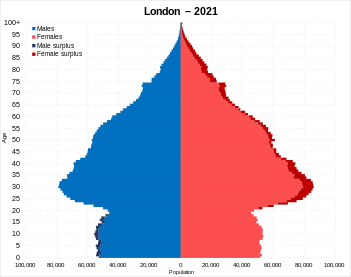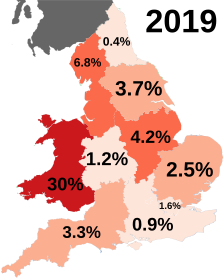Demographics of England
This article contains too many charts, tables, or data. (November 2022) |
| Demographics of England | |
|---|---|
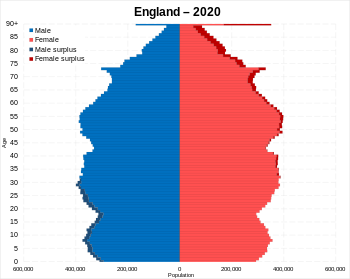 Population pyramid of England in 2021 | |
| Population | 56,489,800 |
| Density | 434/km2 (1,120/sq mi)[1] |
| Fertility rate | 1.61 (2021) |
| Age structure | |
| 0–14 years | 17.4% (2021)[2] |
| 15–64 years | 64.1% |
| 65 and over | 18.6% |
| Nationality | |
| Nationality | English (2021) |
| Major ethnic |
|
| Minor ethnic |
|
| Language | |
| Spoken | British English |


The demography of England has since 1801 been measured by the decennial national census, and is marked by centuries of population growth and urbanization. Due to the lack of authoritative contemporary sources, estimates of the population of England for dates prior to the first census in 1801 vary considerably. The population of England at the 2021 census was about 56,489,800.[4]
Population
[edit]The population of England in 2021 was estimated to be 56,489,800.[4][5] This is the most recent census.[4] In the previous census, in 2011, the population was 53,012,456.
Data for the 2021 census:
- Female: 28,833,712
- Male: 27,656,336
- Total population: 56,489,800 [6]
- Total Fertility Rate: 1.61 (2021)[7]
Historical population
[edit]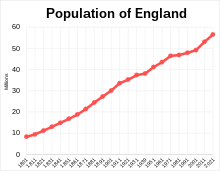
This section needs expansion. You can help by adding to it. (June 2014) |
| Year | Pop. | ±% |
|---|---|---|
| 5000BC | below 6000 | — |
| 3000BC | 100,000 | — |
| 1800BC | 300,000 | +200.0% |
| 100BC | 1,500,000 | +400.0% |
| Source: [8] | ||
| Year | Pop. | ±% |
|---|---|---|
| 1086 | 1,710,000 | — |
| 1190 | 3,100,000 | +81.3% |
| 1220 | 3,970,000 | +28.1% |
| 1250 | 4,230,000 | +6.5% |
| 1279 | 4,430,000 | +4.7% |
| 1290 | 4,750,000 | +7.2% |
| 1315 | 4,690,000 | −1.3% |
| 1325 | 4,120,000 | −12.2% |
| 1348 | 4,810,000 | +16.7% |
| 1351 | 2,600,000 | −45.9% |
| 1377 | 2,500,000 | −3.8% |
| 1400 | 2,080,000 | −16.8% |
| 1430 | 2,020,000 | −2.9% |
| 1450 | 1,900,000 | −5.9% |
| 1490 | 2,140,000 | +12.6% |
| 1522 | 2,350,000 | +9.8% |
| 1541 | 2,830,000 | +20.4% |
| 1560 | 3,200,000 | +13.1% |
| 1600 | 4,110,000 | +28.4% |
| 1650 | 5,310,000 | +29.2% |
| 1700 | 5,200,000 | −2.1% |
| Source: [9] [10] | ||
| Year | Pop. | ±% |
|---|---|---|
| 1801 | 8,287,907 | — |
| 1811 | 9,405,342 | +13.5% |
| 1821 | 11,178,050 | +18.8% |
| 1831 | 12,976,329 | +16.1% |
| 1841 | 14,847,888 | +14.4% |
| 1851 | 16,738,495 | +12.7% |
| 1861 | 18,753,390 | +12.0% |
| 1871 | 21,361,235 | +13.9% |
| 1881 | 24,397,385 | +14.2% |
| 1891 | 27,231,229 | +11.6% |
| 1901 | 30,072,180 | +10.4% |
| 1911 | 33,561,235 | +11.6% |
| 1921 | 35,230,225 | +5.0% |
| 1931 | 37,359,045 | +6.0% |
| 1939 | 38,084,321 | +1.9% |
| 1951 | 41,164,356 | +8.1% |
| 1961 | 43,460,525 | +5.6% |
| 1971 | 46,411,700 | +6.8% |
| 1981 | 46,820,800 | +0.9% |
| 1991 | 47,875,000 | +2.3% |
| 2001 | 49,138,831 | +2.6% |
| 2011 | 53,012,456 | +7.9% |
| 2021 | 56,489,800 | +6.6% |
| 2023 | 57,690,300 | +2.1% |
| Source: Year(s) 1801–2011[10][11][12][13] | ||
Vital statistics
[edit][15] This is UK wide information.
| Average population | Live births | Deaths | Natural change | Crude birth rate (per 1000) | Crude death rate (per 1000) | Natural change (per 1000) | Fertility rates | |
|---|---|---|---|---|---|---|---|---|
| 1940 | 567,710 | 545,952 | 21,758 | 14.1 | 13.6 | 0.5 | ||
| 1941(c) | 539,205 | 499,343 | 39,862 | 13.9 | 12.9 | 1.0 | ||
| 1942 | 608,373 | 448,777 | 159,596 | 15.6 | 11.5 | 4.1 | ||
| 1943 | 641,064 | 469,916 | 171,148 | 16.2 | 11.9 | 4.3 | ||
| 1944 | 704,748 | 461,189 | 243,559 | 17.7 | 11.6 | 6.1 | ||
| 1945 | 638,422 | 456,216 | 182,206 | 15.9 | 11.4 | 4.5 | ||
| 1946 | 773,153 | 460,543 | 312,610 | 19.2 | 11.4 | 7.8 | ||
| 1947 | 829,863 | 484,324 | 345,539 | 20.5 | 12.0 | 8.5 | ||
| 1948 | 728,131 | 439,803 | 288,328 | 17.9 | 10.8 | 7.1 | ||
| 1949 | 686,181 | 478,627 | 207,554 | 16.8 | 11.7 | 5.1 | ||
| 1950 | 654,321 | 477,006 | 177,315 | 15.5 | 11.3 | 4.2 | ||
| 1951(c) | 41,164,356 | 636,259 | 513,375 | 122,884 | 15.5 | 12.5 | 3.0 | |
| 1952 | 632,347 | 466,479 | 165,858 | 15.3 | 11.3 | 4.0 | ||
| 1953 | 642,844 | 472,137 | 170,707 | 15.5 | 11.3 | 4.2 | ||
| 1954 | 633,395 | 469,074 | 164,321 | 15.2 | 11.3 | 3.9 | ||
| 1955 | 628,935 | 484,926 | 144,009 | 15.0 | 11.7 | 3.3 | ||
| 1956 | 659,420 | 488,893 | 170,527 | 15.7 | 11.7 | 4.0 | ||
| 1957 | 681,736 | 482,174 | 199,562 | 16.1 | 11.5 | 4.6 | ||
| 1958 | 698,255 | 494,201 | 204,054 | 16.4 | 11.7 | 4.7 | ||
| 1959 | 706,239 | 495,517 | 210,722 | 16.5 | 11.6 | 4.9 | ||
| 1960 | 740,858 | 493,553 | 247,305 | 17.1 | 11.5 | 5.6 | ||
| 1961(c) | 43,460,525 | 766,358 | 518,047 | 248,311 | 17.6 | 11.9 | 5.7 | |
| 1962 | 793,354 | 523,855 | 269,499 | 18.0 | 12.0 | 6.0 | ||
| 1963 | 807,017 | 538,105 | 268,912 | 18.2 | 12.2 | 6.0 | ||
| 1964 | 828,470 | 501,991 | 326,479 | 18.5 | 11.3 | 7.2 | ||
| 1965 | 816,433 | 516,317 | 300,116 | 18.1 | 11.5 | 6.6 | ||
| 1966 | 804,957 | 528,981 | 275,976 | 17.7 | 11.8 | 5.9 | ||
| 1967 | 788,458 | 509,356 | 279,102 | 17.2 | 11.2 | 6.0 | ||
| 1968 | 775,065 | 541,862 | 233,203 | 16.9 | 11.9 | 5.0 | ||
| 1969 | 754,456 | 543,425 | 211,031 | 16.4 | 11.9 | 4.5 | ||
| 1970 | 741,999 | 540,196 | 201,803 | 16.0 | 11.6 | 4.4 | ||
| 1971(c) | 46,411,700 | 740,099 | 532,445 | 207,654 | 15.9 | 11.5 | 4.4 | |
| 1972 | 46,572,000 | 685,485 | 554,251 | 131,234 | 14.7 | 11.9 | 2.8 | |
| 1973 | 46,686,000 | 638,356 | 549,876 | 88,480 | 13.7 | 11.8 | 1.9 | |
| 1974 | 46,682,000 | 603,153 | 547,980 | 55,173 | 12.9 | 11.7 | 1.2 | |
| 1975 | 46,674,000 | 568,900 | 545,444 | 23,456 | 12.2 | 11.7 | 0.5 | |
| 1976 | 46,659,000 | 550,383 | 560,317 | -9,934 | 11.8 | 12.0 | -0.2 | |
| 1977 | 46,639,000 | 536,953 | 538,652 | -1,699 | 11.5 | 11.5 | -0.0 | |
| 1978 | 46,638,000 | 562,589 | 547,685 | 14,904 | 12.1 | 11.7 | 0.4 | |
| 1979 | 46,698,000 | 601,316 | 554,840 | 46,476 | 12.9 | 11.9 | 1.0 | |
| 1980 | 46,787,000 | 618,371 | 544,349 | 74,022 | 13.2 | 11.6 | 1.6 | |
| 1981(c) | 46,820,800 | 598,163 | 541,018 | 57,145 | 12.8 | 11.6 | 1.2 | |
| 1982 | 46,777,000 | 589,711 | 544,984 | 44,727 | 12.6 | 11.7 | 0.9 | 1.76 |
| 1983 | 46,813,000 | 593,255 | 542,509 | 50,746 | 12.7 | 11.6 | 1.1 | 1.75 |
| 1984 | 46,912,000 | 600,573 | 531,314 | 69,259 | 12.8 | 11.3 | 1.5 | 1.75 |
| 1985 | 47,057,000 | 619,301 | 553,153 | 66,148 | 13.2 | 11.8 | 1.4 | 1.78 |
| 1986 | 47,187,000 | 623,609 | 544,545 | 79,064 | 13.2 | 11.5 | 1.7 | 1.76 |
| 1987 | 47,300,000 | 643,330 | 531,150 | 112,180 | 13.6 | 11.2 | 2.4 | 1.80 |
| 1988 | 47,412,000 | 654,353 | 535,553 | 118,800 | 13.8 | 11.3 | 2.5 | 1.82 |
| 1989 | 47,552,000 | 649,357 | 539,804 | 109,553 | 13.7 | 11.4 | 2.3 | 1.79 |
| 1990 | 47,699,000 | 666,920 | 528,920 | 138,000 | 14.0 | 11.1 | 3.9 | 1.83 |
| 1991(c) | 47,875,000 | 660,806 | 533,980 | 126,826 | 13.8 | 11.2 | 2.6 | 1.81 |
| 1992 | 47,998,000 | 651,784 | 522,660 | 129,124 | 13.6 | 10.9 | 2.7 | 1.79 |
| 1993 | 48,102,000 | 636,473 | 540,904 | 95,569 | 13.2 | 11.2 | 2.0 | 1.76 |
| 1994 | 48,228,000 | 628,956 | 516,297 | 112,659 | 13.0 | 10.7 | 2.3 | 1.75 |
| 1995 | 48,383,000 | 613,257 | 529,038 | 84,219 | 12.7 | 10.9 | 1.8 | 1.71 |
| 1996 | 48,519,000 | 614,184 | 526,650 | 87,534 | 12.7 | 10.9 | 1.8 | 1.73 |
| 1997 | 48,664,000 | 608,202 | 521,598 | 86,604 | 12.5 | 10.7 | 1.8 | 1.73 |
| 1998 | 48,820,000 | 602,111 | 518,089 | 84,022 | 12.3 | 10.6 | 1.7 | 1.72 |
| 1999 | 49,032,000 | 589,468 | 517,119 | 72,349 | 12.0 | 10.5 | 1.5 | 1.69 |
| 2000 | 49,233,000 | 572,826 | 503,026 | 69,800 | 11.6 | 10.2 | 1.4 | 1.65 |
| 2001(c) | 49,449,000 | 563,744 | 497,878 | 65,866 | 11.4 | 10.1 | 1.3 | 1.63 |
| 2002 | 49,679,000 | 565,709 | 500,792 | 64,917 | 11.4 | 10.1 | 1.3 | 1.64 |
| 2003 | 49,925,000 | 589,851 | 504,127 | 85,724 | 11.8 | 10.1 | 1.7 | 1.72 |
| 2004 | 50,194,000 | 607,184 | 480,717 | 126,467 | 12.1 | 9.6 | 2.5 | 1.77 |
| 2005 | 50,606,000 | 613,028 | 479,678 | 133,350 | 12.1 | 9.5 | 2.6 | 1.77 |
| 2006 | 50,965,000 | 635,748 | 470,326 | 165,422 | 12.5 | 9.2 | 3.3 | 1.83 |
| 2007 | 51,381,000 | 655,357 | 470,721 | 184,636 | 12.8 | 9.2 | 3.6 | 1.88 |
| 2008 | 51,815,000 | 672,809 | 475,763 | 197,046 | 13.0 | 9.2 | 3.8 | 1.92 |
| 2009 | 52,196,000 | 671,058 | 459,241 | 211,817 | 12.9 | 8.8 | 4.1 | 1.91 |
| 2010 | 52,642,000 | 687,007 | 461,017 | 225,990 | 13.1 | 8.8 | 4.3 | 1.94 |
| 2011(c) | 53,107,000 | 688,120 | 452,862 | 235,258 | 13.0 | 8.5 | 4.5 | 1.93 |
| 2012 | 53,493,000 | 694,241 | 466,779 | 227,462 | 13.0 | 8.7 | 4.3 | 1.94 |
| 2013 | 53,865,000 | 664,517 | 473,552 | 190,965 | 12.3 | 8.8 | 3.5 | 1.85 |
| 2014 | 54,316,000 | 661,496 | 468,875 | 192,621 | 12.2 | 8.6 | 3.6 | 1.83 |
| 2015 | 54,786,000 | 664,399 | 495,309 | 169,090 | 12.1 | 9.0 | 3.1 | 1.82 |
| 2016 | 55,268,000 | 663,157 | 490,454 | 172,703 | 12.0 | 8.9 | 3.1 | 1.81 |
| 2017 | 55,619,000 | 646,794 | 498,882 | 147,912 | 11.6 | 9.0 | 2.6 | 1.76 |
| 2018 | 55,977,000 | 625,651 | 505,859 | 119,792 | 11.2 | 9.0 | 2.2 | 1.70 |
| 2019 | 56,287,000 | 610,505 | 488,952 | 121,553 | 10.8 | 8.7 | 2.1 | 1.66 |
| 2020 | 56,550,000 | 585,195 | 569,700 | 15,495 | 10.3 | 10.1 | 0.3 | 1.59 |
| 2021(c) | 56,489,800 | 595,948 | 549,207 | 46,741 | 10.5 | 9.7 | 0.8 | 1.56 |
| 2022 | 57,106,398 | 577,046 | 540,333 | 36,713 | 10.2 | 9.5 | 0.7 | 1.49 |
| 2023 | 57,690,300 | 563,561 | 544,032 | 19,529 | 9.8 | 9.4 | 0.4 | 1.44 |
(c) = Census results.
In 2022, the percentage of live births where either one or both parents were born outside of the UK was 36.7%. 31.1% of all live births in England were to mothers born outside of the UK (9.8% born in the EU, 21.3% born outside of the EU).[16]
Current vital statistics
[edit]| Period | Live births | Deaths | Natural increase |
|---|---|---|---|
| January - September 2023 | 411,060 | ||
| January - September 2024 | 397,154 | ||
| Difference |
Historical per cent distribution of the total population by age
[edit]| Ages | 1901 | 1931 | 1951 | 1961 |
|---|---|---|---|---|
| 0–14 years | 32 | 24 | 22 | 23 |
| 15–64 years | 63 | 69 | 67 | 65 |
| 65 years and over | 5 | 7 | 11 | 12 |
| Total (%) | 100 | 100 | 100 | 100 |
Country of birth
[edit]Country of birth given by respondents in the corresponding UK censuses were as follows:
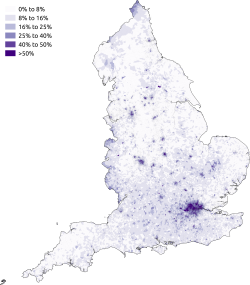
| Country of birth | 1971[19] | 1981[20] | 1991[21] | 2001[22] | 2011[23] | 2021[24] | ||||||
|---|---|---|---|---|---|---|---|---|---|---|---|---|
| Number | % | Number | % | Number | % | Number | % | Number | % | Number | % | |
| 41,951,042 | 91.3% | 42,620,882 | 93.1% | 43,506,411 | 92.46% | 44,594,817 | 90.75% | 45,675,317 | 86.16% | 46,687,505 | 82.65% | |
| 40,374,714 | 87.9% | 41,084,399 | 89.8% | 42,003,211 | 89.3% | 42,968,596 | 87.44% | 44,246,592 | 83.46% | 45,388,724 | 80.35% | |
| 716,499 | 1.6% | 731,412 | 1.7% | 743,856 | 1.58% | 794,577 | 1.62% | 708,872 | 1.34% | 626,443 | 1.11% | |
| 632,548 | 1.4% | 573,014 | 1.3% | 545,381 | 1.16% | 609,711 | 1.24% | 506,619 | 0.96% | 478,697 | 0.85% | |
| 227,281 | 0.5% | – | – | 211,133 | 0.45% | 215,124 | 0.44% | 206,735 | 0.39% | 190,541 | 0.34% | |
| – | – | 232,057 | 2,830 | 0.01% | 6,809 | 0.01% | 6,499 | 0.01% | 2,612 | |||
| Europe (non-UK) | 1,217,245 | 2.7% | 1,142,182 | 2.4% | 1,196,524 | 2.5% | 1,450,260 | 2.95% | 2,375,441 | 4.5% | 4,042,538 | 7.16% |
| 647,429 | 1.4% | 567,021 | 1.3% | 555,805 | 1.18% | 460,287 | 0.94% | 395,182 | 0.75% | 314,674 | 0.56% | |
| Channel Islands & Isle of Man | – | – | – | – | 26,303 | 0.06% | 27,550 | 0.06% | 24,653 | 0.05% | ||
| Total born in all EU Member Countries (excluding Ireland) | 569,816[note 1] | 1.2% | 340,113 | 0% | 452,092 | 1% | 660,061 | 1.34% | 1,980,259 | 3.73% | 3,236,799 | 5.73% |
| EU Member Countries (joined pre 2001) or EEC Members | – | – | 340,113 | 452,092 | 1% | – | – | 894,908 | 1.69% | 1,263,707 | 2.24% | |
| – | – | – | – | 193,346 | 0.41% | 233,418 | 0.48% | 262,356 | 0.49% | 252,252 | 0.45% | |
| – | – | – | – | 83,724 | 0.18% | 98,757 | 0.20% | 131,195 | 0.25% | 272,019 | 0.48% | |
| – | – | – | – | 49,947 | 0.11% | 87,562 | 0.18% | 127,601 | 0.24% | 152,697 | 0.27% | |
| – | – | – | – | 37,006 | 0.08% | 50,431 | 0.10% | 77,554 | 0.15% | 163,848 | 0.29% | |
| Other EU Member Countries
(joined post-2001) |
– | – | – | – | – | – | – | – | 1,085,351 | 2.04% | 1,973,092 | 3.49% |
| – | – | – | – | 68,049 | 0.14% | 56,679 | 0.12% | 561,098 | 1.06% | 718,251 | 1.27% | |
| – | – | – | – | 3,762 | 0.01% | 7,077 | 0.01% | 78,192 | 0.15% | 530,320 | 0.94% | |
| Other non-EU Europe | – | – | 235,048 | 0.5% | 115,247 | 0.2% | – | – | – | – | 491,065 | 0.87% |
| – | – | – | – | 26,016 | 0.06% | 52,402 | 0.11% | 89,484 | 0.17% | 124,758 | 0.22% | |
| – | – | – | – | 25,235 | 0.05% | 27,250 | 0.06% | – | – | – | – | |
| Africa | 148,473 | 0.3% | 278,678 | 0.6% | 456,396 | 1% | 798,218 | 1.62% | 1,290,611 | 2.43% | 1,558,199 | 2.76% |
| – | – | – | – | 21,220 | 0.05% | 129,302 | 0.26% | 186,355 | 0.35% | 211,447 | 0.37% | |
| – | – | – | – | 109,610 | 0.23% | 126,119 | 0.26% | 135,966 | 0.26% | 133,416 | 0.24% | |
| – | – | – | – | 45,873 | 0.10% | 86,370 | 0.18% | 188,690 | 0.36% | 266,877 | 0.47% | |
| Middle East and Asia | 522,263 | 1.1% | 727,838 | 1.6% | 1,108,529 | 2.4% | 1,778,296 | 3.62% | 2,529,137 | 4.77% | 3,241,701 | 5.74% |
| 301,862 | 0.7% | 378,721 | 0.9% | 395,563 | 0.84% | 450,493 | 0.92% | 682,274 | 1.29% | 906,962 | 1.61% | |
| 131,826 | 0.3% | 179,712 | 0.4% | 221,776 | 0.47% | 304,706 | 0.62% | 476,684 | 0.90% | 616,454 | 1.09% | |
| 46,873 | 0.1% | 101,829 | 0.22% | 150,057 | 0.31% | 206,331 | 0.39% | 266,290 | 0.47% | |||
| 15,366 | – | – | 38,145 | 0.08% | 66,330 | 0.13% | 125,917 | 0.24% | 141,861 | 0.25% | ||
| Far East | 73,209 | 122,532 | 0.3% | – | – | 360,604 | 0.73% | – | – | – | – | |
| – | – | – | – | 64,496 | 0.14% | 84,770 | 0.17% | 98,724 | 0.19% | 117,714 | 0.21% | |
| – | – | – | – | 21,292 | 0.05% | 47,201 | 0.10% | 146,202 | 0.28% | 176,072 | 0.31% | |
| Americas and Caribbean | 292,966 | 0.6% | 291,679 | 0.6% | 481,299 | 1% | – | – | 663,091 | 1.25% | 790,002 | 1.40% |
| – | – | – | – | 128,337 | 0.27% | 141,198 | 0.29% | 173,470 | 0.33% | 198,656 | 0.35% | |
| – | – | – | – | 141,352 | 0.30% | 145,234 | 0.30% | 159,170 | 0.30% | 141,289 | 0.25% | |
| – | – | – | – | 53,195 | 0.11% | 59,356 | 0.12% | 66,320 | 0.13% | 66,847 | 0.12% | |
| Antarctica and Oceania | – | – | – | – | 104,141 | 0.2% | – | – | 179,200 | 0.34% | 170,023 | 0.30% |
| – | – | – | – | 66,279 | 0.14% | 96,437 | 0.20% | 113,592 | 0.21% | 109,963 | 0.19% | |
| – | – | – | – | 37,862 | 0.08% | 53,466 | 0.11% | 57,076 | 0.11% | 47,842 | 0.08% | |
| Other: Old Commonwealth[note 2] | 119,683 | 0.3% | 133,220 | 0.3% | – | – | – | – | – | – | – | – |
| Other: New Commonwealth[note 3] | 109,971 | 0.2% | 155,389 | 0.3% | 147,602 | 0.3% | – | – | – | – | – | – |
| Other Countries (non Europe or UK for 2001–2021) | 482,351 | 1% | 421,895 | 0.9% | – | – | 3,093,754 | 6.30% | 4,961,698 | 9.36% | 5,760,008 | 10.20% |
| Total | 45,917,667 | 100% | 45,771,763 | 100% | 47,055,204 | 100% | 49,138,831 | 100.00% | 53,012,456 | 100.00% | 56,490,051 | 100% |
Below are the estimates of the largest foreign-born groups in England according to ONS estimates.
| Country of birth | 2013 | 2014[25] | 2015 | 2018[26] |
|---|---|---|---|---|
| 698,000 | 748,000 | 751,000 | 832,000 | |
| 561,000 | 677,000 | 713,000 | 832,000 | |
| 479,000 | 499,000 | 478,000 | 535,000 | |
| 315,000 | 317,000 | 318,000 | 369,000 | |
| 263,000 | 267,000 | 253,000 | 309,000 |
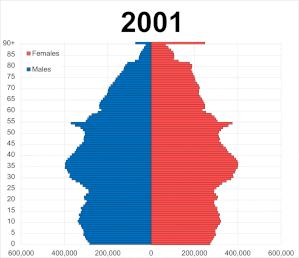
Age
[edit]
The data below is based on the 2011 census.[27] In 2001, the mean age of England's population was 38.60, and the median age was 37.00. In 2022, the median age was 40.5.[28]
| Ages attained (years) |
Population | % of total population |
% per year of age band |
|---|---|---|---|
| 0–4 | 3,318,449 | 6.26 | 1.25 |
| 5–9 | 2,972,632 | 5.61 | 1.12 |
| 10–14 | 3,080,929 | 5.81 | 1.16 |
| 15–19 | 3,340,265 | 6.30 | 1.26 |
| 20–24 | 3,595,321 | 6.78 | 1.36 |
| 25–29 | 3,650,881 | 6.89 | 1.38 |
| 30–34 | 3,509,221 | 6.62 | 1.32 |
| 35–39 | 3,549,116 | 6.69 | 1.34 |
| 40–44 | 3,885,934 | 7.33 | 1.47 |
| 45–49 | 3,879,815 | 7.32 | 1.46 |
| 50–54 | 3,400,095 | 6.41 | 1.28 |
| 55–59 | 2,996,992 | 5.65 | 1.13 |
| 60–64 | 3,172,277 | 5.98 | 1.20 |
| 65–69 | 2,508,154 | 4.73 | 0.95 |
| 70–74 | 2,044,129 | 3.86 | 0.77 |
| 75–79 | 1,669,345 | 3.15 | 0.63 |
| 80–84 | 1,258,773 | 2.37 | 0.47 |
| 85–89 | 776,311 | 1.46 | 0.29 |
| 90+ | 403,817 | 0.76 | – |
- Population pyramids of the regions of England
-
South West
-
South East
-
Greater London
-
East of England
-
East Midlands
-
West Midlands
-
Yorkshire and the Humber
-
North West
-
North East
Ethnicity
[edit]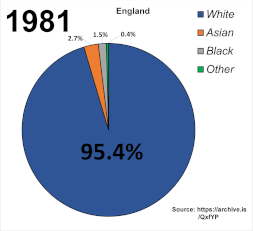
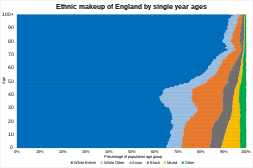
| Ethnic group (reported as 'Area of origin') | 1951[note 4] | 1961[note 4] | 1966 | mid-1968 | ||||||
|---|---|---|---|---|---|---|---|---|---|---|
| Estimates based solely off of immigrant population[note 4] | Total estimated (including estimates of those born in the UK)[note 5] | |||||||||
| Population | % | Population | % | Population | % | Population | % | Population | % | |
| White: Total | 43,683,500 | 99.83% | 45,769,000 | 99.28% | 46,540,500 | 98.73% | 46,211,500 | 98.04% | – | – |
| Non-White: Total | 74,500 | 0.17% | 336,000 | 0.72% | 595,000 | 1.27% | 924,000 | 1.96% | 1,123,000 | – |
| India | 30,800 | 81,400 | 163,600 | 223,000 | – | – | ||||
| Pakistan | 5,000 | 24,900 | 67,700 | 199,700 | – | – | ||||
| Ceylon (Sri Lanka) | 5,800 | 9,000 | 12,900 | 16,100 | – | – | ||||
| West Indies | 15,300 | 171,800 | 267,900 | – | – | – | – | |||
| Jamaica | – | – | – | – | – | – | 278,000 | – | – | |
| Other Caribbean | – | – | – | – | – | – | 180,300 | – | – | |
| British West Africa (Gambia, Ghana, Nigeria and Sierra Leone) | 5,600 | 19,800 | 36,000 | 50,700 | – | – | ||||
| Far East (Hong Kong, Malaya, Singapore) | 12,000 | 29,600 | 47,000 | 60,000 | – | – | ||||
| Total population | 43,758,000 | 100% | 46,105,000 | 100% | 47,135,500 | 100% | 47,135,500 | 100% | – | – |
| Ethnic group | Year | |||||||||
|---|---|---|---|---|---|---|---|---|---|---|
| 1981 estimations[30] | 1991[31][note 6] | 2001[32] | 2011[33] | 2021[34] | ||||||
| Population | % | Population | % | Population | % | Population | % | Population | % | |
| White: Total | – | 95.4% | 44,144,339 | 93.8% | 44,679,361 | 91% | 45,281,142 |
85.4% |
45,783,401 | 81% |
| White: British | – | – | – | – | 42,747,136 | 87.0% | 42,279,236 | 79.8% | 41,540,791 | 73.5% |
| White: Irish | – | – | – | – | 624,115 | 1.3% | 517,001 | 1.0% | 494,251 | 0.9% |
| White: Irish Traveller/White Gypsy | – | – | – | – | – | – | 54,895 | 0.1% | 64,218 | 0.1% |
| White: Roma | – | – | – | – | – | – | – | – | 99,138 | 0.2% |
| White: Other | – | – | – | – | 1,308,110 | 2.7% | 2,430,010 | 4.6% | 3,585,003 | 6.3% |
| Asian or Asian British: Total | – | 2.65% | 1,762,262 | 3.7% | 2,468,970 | 5% | 4,143,403 |
7.8% |
5,426,392 | 9.7% |
| Asian or Asian British: Indian | – | 1.32% | 823,821 | 1.8% | 1,028,546 | 2.1% | 1,395,702 | 2.6% | 1,843,248 | 3.3% |
| Asian or Asian British: Pakistani | – | 0.7% | 449,646 | 1.0% | 706,539 | 1.4% | 1,112,282 | 2.1% | 1,570,285 | 2.8% |
| Asian or Asian British: Bangladeshi | – | 0.18% | 157,881 | 0.3% | 275,394 | 0.6% | 436,514 | 0.8% | 629,567 | 1.1% |
| Asian or Asian British: Chinese[note 7] | – | 0.22% | 141,661 | 0.3% | 220,681 | 0.5% | 379,502 | 0.7% | 431,165 | 0.8% |
| Asian or Asian British: Asian Other | – | 0.23% | 189,253 | 0.4% | 237,810 | 0.5% | 819,403 | 1.6% | 952,127 | 1.7% |
| Black or Black British: Total | – | 1.51% | 874,882 | 1.9% | 1,132,508 | 2.3% | 1,846,614 |
3.5% |
2,381,724 | 4.2% |
| Black or Black British: Caribbean | – | 0.91% | 495,682 | 1.1% | 561,246 | 1.1% | 591,016 | 1.1% | 619,419 | 1.1% |
| Black or Black British: African | – | 0.3% | 206,918 | 0.4% | 475,938 | 1.0% | 977,741 | 1.8% | 1,468,474 | 2.6% |
| Black or Black British: Other | – | 0.3% | 172,282 | 0.4% | 95,324 | 0.2% | 277,857 | 0.5% | 293,831 | 0.5% |
| British Mixed: Total | – | – | – | – | 643,373 | 1.3% | 1,192,879 |
2.3% |
1,669,378 | 2.9% |
| Mixed: White and Caribbean | – | – | – | – | 231,424 | 0.5% | 415,616 | 0.8% | 499,310 | 0.9% |
| Mixed: White and African | – | – | – | – | 76,498 | 0.2% | 161,550 | 0.3% | 241,528 | 0.4% |
| Mixed: White and Asian | – | – | – | – | 184,014 | 0.4% | 332,708 | 0.6% | 474,190 | 0.8% |
| Mixed: Other Mixed | – | – | – | – | 151,437 | 0.3% | 283,005 | 0.3% | 454,350 | 0.8% |
| Other: Total | – | 0.44% | 273,721 | 0.6% | 214,619 | 0.4% | 548,418 |
1.0% |
1,229,153 | 2.2% |
| Other: Arab | – | – | – | – | – | – | 220,985 | 0.4% | 320,203 | 0.6% |
| Other: Any other ethnic group | – | 0.44% | 273,721 | 0.6% | 214,619 | 0.4% | 327,433 | 0.6% | 908,950 | 1.6% |
| Non-White: Total | – | 4.6% | 2,910,865 | 6.2% | 4,459,470 | 9% | 7,731,314 | 14.6% | 10,706,647 | 19% |
| Total | – | 100% | 47,055,204 | 100% | 49,138,831 | 100% | 53,012,456 |
100% |
56,490,048 | 100% |
Notes for table above
- ^ Figure accounts for all of Europe apart from Ireland
- ^ Used as main option for when no other options are given, for example in 1971. This group contains all for Canada, Australia and New Zealand
- ^ Used as a conglomerate for New Commonwealth for when there are no other options as for example in 1971. This group contains all for remenents of the British Empire after 1945 (if not already indicated).
- ^ a b c Estimates taken solely from the immigrant population at the time excluding estimates of those that were white from these areas.
- ^ Estimates are taken from a combined estimate of the immigrant population (excluding estimates of white people), additional non-white people who may not have been enumerated, and estimates of non-white people born in the UK from parents from shown areas
- ^ The number of people who answered the census may not equal the estimated population total at the time due to the fact an estimated 1 million people did not answer the form.
- ^ In 2001, listed under the 'Chinese or other ethnic group' heading.
Population distribution
[edit]- Population distribution of ethnic groups in 2011
-
Other White (4.6%)
-
Asian/Asian British: Indian (2.6%)
-
Asian/Asian British: Pakistani (2.1%)
-
Asian/Asian British: Bangladeshi (0.8%)
-
Black/Black British: Total (3.5%)
-
Other: Arab (0.4%)
- Proportion of births in regions of each broad multi-ethnic group
-
White
-
Asian
-
Black
-
Mixed
-
All other ethnic groups
-
Births which did not state an ethnicity
Ethnicity of school pupils
[edit]The ethnicity of school pupils in England has been changing since the figures started to be collected in 2002, White British students proportionally have been in decline compared to other groups who have risen.
| Ethnic group | School year[35][36] | |||||||||||||||||||
|---|---|---|---|---|---|---|---|---|---|---|---|---|---|---|---|---|---|---|---|---|
| 1997[37] | 2004 | 2008 | 2010 | 2014 | 2015/16 | 2017/18 | 2019/20 | 2021/22 | 2023/24 | |||||||||||
| Number | % | Number | % | Number | % | Number | % | Number | % | Number | % | Number | % | Number | % | Number | % | Number | % | |
| White: Total | 5,976,100 | 89% | 5,584,800 | 82.9% | 5,389,340 | 81.3% | 5,243,870 | 79.9% | 5,222,070 | 76.9% | 5,258,582 | 75.6% | 6,027,781 | 74% | 6,048,980 | 72.8% | 6,011,045 | 71.4% | 5,877,640 | 69.1% |
| White: British | – | – | 5,408,700 | 80.3% | 5,136,610 | 77.4% | 4,963,110 | 75.6% | 4,859,730 | 71.6% | 4,822,332 | 69.3% | 5,454,108 | 66.9% | 5,432,991 | 65.4% | 5,379,748 | 63.9% | 5,212,524 | 61.3% |
| White: Irish | – | – | 26,100 | 0.3% | 23,620 | 0.4% | 22,190 | 0.3% | 21,640 | 0.3% | 21,127 | 0.3% | 23,110 | 0.3% | 22,443 | 0.3% | 21,495 | 0.3% | 20,677 | 0.2% |
| White: Roma | – | – | 6,500 | 0.1% | 3,940 | 0.1% | 4,000 | 0.1% | 4,625 | 0.1% | 22,092 | 0.3% | 26,653 | 0.3% | 28,091 | 0.3% | 27,359 | 0.3% | 28,594 | 0.3% |
| White: Irish Traveller | – | – | 3,900 | 0.1% | 8,770 | 0.1% | 10,990 | 0.2% | 19,030 | 0.3% | 4,975 | 0.1% | 6,008 | 0.1% | 6,578 | 0.1% | 6,903 | 0.1% | 6,798 | 0.1% |
| White: Other | – | – | 139,600 | 2.1% | 216,410 | 3.3% | 243,580 | 3.7% | 317,055 | 4.7% | 388,056 | 5.6% | 517,902 | 6.4% | 558,877 | 6.7% | 575,540 | 6.8% | 609,047 | 7.2% |
| Asian / Asian British: Total | – | – | 476,900 | 7.1% | 536,420 | 8.1% | 575,670 | 8.8% | 676,920 | 10.0% | 755,817 | 10.8% | 937,983 | 11.4% | 985,795 | 11.9% | 1,040,541 | 12.3% | 1,129,383 | 13.4% |
| Asian / Asian British: Indian | – | – | 154,400 | 2.3% | 161,150 | 2.4% | 163,780 | 2.5% | 180,995 | 2.7% | 196,351 | 2.8% | 247,280 | 3.0% | 268,318 | 3.2% | 289,179 | 3.4% | 337,382 | 4.0% |
| Asian / Asian British: Pakistani | – | – | 180,600 | 2.7% | 214,210 | 3.2% | 231,380 | 3.5% | 273,465 | 4.0% | 293,089 | 4.2% | 360,554 | 4.4% | 372,699 | 4.5% | 380,781 | 4.5% | 388,315 | 4.6% |
| Asian / Asian British: Bangladeshi | – | – | 72,000 | 1.1% | 87,320 | 1.3% | 95,420 | 1.5% | 110,735 | 1.6% | 117,004 | 1.7% | 143,379 | 1.8% | 148,290 | 1.8% | 151,613 | 1.8% | 151,875 | 1.8% |
| Asian / Asian British: Chinese | – | – | 23,700 | 0.4% | 24,780 | 0.4% | 24,690 | 0.4% | 26,725 | 0.4% | 28,915 | 0.4% | 36,196 | 0.4% | 37,732 | 0.5% | 48,396 | 0.6% | 63,774 | 0.8% |
| Asian / Asian British: Other Asians | – | – | 46,200 | 0.7% | 73,770 | 1.1% | 85,080 | 1.3% | 111,720 | 1.6% | 120,458 | 1.7% | 150,574 | 1.8% | 158,756 | 1.9% | 170,572 | 2.0% | 188,037 | 2.2% |
| Black / Black British: Total | – | – | 244,900 | 3.6% | 292,860 | 4.4% | 312,260 | 4.8% | 366,130 | 5.4% | 389,585 | 5.5% | 464,367 | 5.7% | 474,570 | 5.7% | 486,517 | 5.8% | 551,099 | 6.5% |
| Black: Caribbean | – | – | 96,100 | 1.4% | 92,090 | 1.4% | 91,400 | 1.4% | 89,350 | 1.3% | 85,830 | 1.2% | 91,429 | 1.1% | 86,543 | 1.0% | 82,402 | 1.0% | 78,817 | 0.9% |
| Black: African | – | – | 120,900 | 1.8% | 167,990 | 2.5% | 184,790 | 2.8% | 232,065 | 3.4% | 253,781 | 3.6% | 311,012 | 3.8% | 323,874 | 3.9% | 338,614 | 4.0% | 406,246 | 4.8% |
| Black: Other Blacks | – | – | 27,900 | 0.4% | 32,770 | 0.5% | 36,070 | 0.5% | 44,710 | 0.7% | 49,974 | 0.7% | 61,926 | 0.8% | 64,153 | 0.8% | 65,501 | 0.8% | 66,036 | 0.8% |
| Mixed / British Mixed | – | – | 181,500 | 2.7% | 229,650 | 3.5% | 256,980 | 3.9% | 325,140 | 4.8% | 363,730 | 5.3% | 473,305 | 5.8% | 515,061 | 6.1% | 558,184 | 6.6% | 594,344 | 7.0% |
| Mixed: White and Caribbean | – | – | 64,600 | 1.0% | 77,350 | 1.2% | 82,410 | 1.3% | 95,785 | 1.4% | 101,278 | 1.5% | 123,873 | 1.5% | 128,774 | 1.5% | 133,504 | 1.6% | 134,384 | 1.6% |
| Mixed: White and African | – | – | 17,000 | 0.3% | 24,110 | 0.4% | 27,860 | 0.4% | 40,245 | 0.6% | 47,472 | 0.7% | 63,518 | 0.8% | 70,403 | 0.8% | 76,262 | 0.9% | 79,940 | 0.9% |
| Mixed: White and Asian Other | – | – | 36,300 | 0.5% | 47,510 | 0.7% | 54,610 | 0.8% | 73,555 | 1.1% | 84,133 | 1.2% | 111,811 | 1.4% | 123,153 | 1.5% | 134,821 | 1.6% | 143,206 | 1.7% |
| Mixed: Other Mixed | – | – | 63,500 | 0.9% | 80,680 | 1.2% | 92,110 | 1.4% | 115,560 | 1.7% | 130,847 | 1.9% | 174,103 | 2.1% | 192,731 | 2.3% | 213,597 | 2.5% | 236,814 | 2.8% |
| Other: Total | – | – | 57,900 | 0.9% | 78,560 | 1.2% | 86,880 | 1.3% | 106,115 | 1.6% | 119,647 | 1.7% | 154,575 | 1.9% | 168,758 | 2.0% | 185,355 | 2.2% | 203,561 | 2.4% |
| Unclassified | – | – | 190,700 | 2.8% | 81,300 | 1.2% | 64,610 | 1.0% | 67,935 | 1.0% | 67,126 | 1.0% | 94,312 | 1.2% | 119,388 | 1.4% | 136,371 | 1.6% | 141,908 | 1.7% |
| Total: | 6,716,700 | 100% | 6,736,700 | 100% | 6,632,900 | 100% | 6,564,940 | 100% | 6,791,030 | 100% | 6,954,487 | 100% | 8,152,323 | 100% | 8,312,552 | 100% | 8,418,013 | 100% | 8,497,935 | 100% |
- Ethnicity of school pupils in the school year of 2021/2022
-
White: 71.4%
-
White British: 63.9%
Languages
[edit]The most common main languages spoken in England according to the 2011 census are shown below.[38]
| Rank | Language | Usual residents aged 3+ | Proportion |
|---|---|---|---|
| 1 | English | 46,936,780 | 92.02% |
| 2 | Polish | 529,173 | 1.04% |
| 3 | Punjabi | 271,580 | 0.53% |
| 4 | Urdu | 266,330 | 0.52% |
| 5 | Bengali (with Sylheti and Chatgaya) | 216,196 | 0.42% |
| 6 | Gujarati | 212,217 | 0.42% |
| 7 | Arabic | 152,490 | 0.30% |
| 8 | French | 145,026 | 0.28% |
| 9 | Portuguese | 131,002 | 0.26% |
| 10 | Spanish | 118,554 | 0.23% |
| 11 | Tamil | 99,773 | 0.20% |
| 12 | Turkish | 98,083 | 0.19% |
| 13 | Italian | 90,547 | 0.18% |
| 14 | Somali | 84,387 | 0.17% |
| 15 | Lithuanian | 84,327 | 0.17% |
| 16 | German | 75,190 | 0.15% |
| 17 | Persian/Farsi | 75,179 | 0.15% |
| 18 | Tagalog/Filipino | 67,593 | 0.13% |
| 19 | Romanian | 66,496 | 0.13% |
| 20 | Russian | 66,271 | 0.13% |
| – | Welsh | 8,248 | 0.02% |
| – | Cornish | 554 | 0.00% |
| – | Other | 1,209,614 | 2.37% |
| Population | 51,005,610 | 100.00% |
Religion
[edit]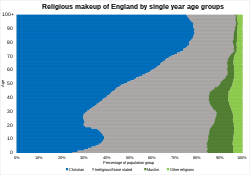
Religion in England (2021 census)
Respondents to the 2001, 2011 and 2021 censuses gave their religions as follows:
| Religion | 2001[39] | 2011[40] | 2021[41] | |||
|---|---|---|---|---|---|---|
| Number | % | Number | % | Number | % | |
| Christian | 35,251,244 | 71.74% | 31,479,876 | 59.38% | 26,167,899 | 46.3 |
| Muslim | 1,524,887 | 3.10% | 2,660,116 | 5.02% | 3,801,186 | 6.7 |
| Hindu | 546,982 | 1.11% | 806,199 | 1.52% | 1,032,533 | 1.8 |
| Sikh | 327,343 | 0.67% | 420,196 | 0.79% | 520,092 | 0.9 |
| Jewish | 257,671 | 0.52% | 261,282 | 0.49% | 269,283 | 0.5 |
| Buddhist | 139,046 | 0.28% | 238,626 | 0.45% | 262,433 | 0.5 |
| Other religion | 143,811 | 0.29% | 227,825 | 0.43% | 332,410 | 0.6 |
| No religion | 7,171,332 | 14.59% | 13,114,232 | 24.74% | 20,715,664 | 36.7 |
| Religion not stated | 3,776,515 | 7.69% | 3,804,104 | 7.18% | 3,400,548 | 6.0 |
| Total population | 49,138,831 | 100.00% | 53,012,456 | 100.00% | 56,490,048 | 100.0 |
See also
[edit]- Demographics of the United Kingdom
- Demographics of Scotland
- Demographics of Wales
- Demographics of Northern Ireland
- Demographics of London
- Demographics of Birmingham
- Demographics of Greater Manchester
- United Kingdom Census 2011
- National Statistics Socio-economic Classification
- Census 2001 Ethnic Codes
- List of English districts by population
- List of urban areas in England by population
- List of towns and cities in England by historical population
- List of major settlements by population in English counties
Notes
[edit]References
[edit]- ^ "Population estimates for the UK, England, Wales, Scotland and Northern Ireland - Office for National Statistics". www.ons.gov.uk.
- ^ "Population and household estimates, England and Wales: Census 2021". GOV.UK.
- ^ "Create a custom dataset - Office for National Statistics". www.ons.gov.uk.
- ^ a b c "Population and household estimates, England and Wales - Office for National Statistics". www.ons.gov.uk. Retrieved 28 June 2022.
- ^ "Population estimates - Office for National Statistics". www.ons.gov.uk.
- ^ "Custom dataset - Office for National Statistics". Office for National Statistics. 21 March 2021. Retrieved 8 June 2023.
- ^ "National Statistics Online – Live births". Statistics.gov.uk. Retrieved 9 August 2022.
- ^ Pryor, Francis (2004). Britain BC: Life in Britain and Ireland Before the Romans. London: Harper Perennial. ISBN 978-0007126934.
- ^ S. Broadberry et al (2010), "English Medieval Population: Reconciling Time Series and Cross Sectional Evidence", Table 7 (Preprint, p.22); S. Broadberry et al (2010), "British Economic Growth 1270–1870", Table 18 (Preprint, p. 54); see also S. Broadberry et al (2015), British Economic Growth 1270–1870, Cambridge University Press, ISBN 1107070783, Chapter 1, and Table 5.06, pg 205
See also B. Campbell (1990), "People and Land in the Middle Ages, 1066–1500", in Robert A. Dodgshon and Robin A. Butlin (eds), Historical Geography of England and Wales, 2nd edition. Elsevier. ISBN 1483288412, pp. 69–122 for discussion of drivers and trends underlying the numbers. - ^ a b Wrigley and Schofield, "The Population History of England, 1541–1871. A reconstruction.", Harvard University Press, 1981, Table 7.8, pgs. 208-9, [1]
- ^ At the time of the first census. Census officials estimated that there had been an increase of 77% in the preceding 100 years. In each county women were in the majority. Notes for 1801 taken from Kent 1800–1899 – A Chronicle of the Nineteenth Century Bob Ogley (Froglets Publications 2003) ISBN 1-872337-51-1. Wrigley and Schofield estimate 8,664,000 based on birth and death records.]
- ^ Vision of Britain a population through time England, Retrieved 9 August 2013
- ^ 2011 Census: Population Estimates for the United Kingdom, 27 March 2011 (PDF), ONS, 12 December 2011, archived from the original (PDF) on 5 January 2016, retrieved 9 August 2013
- ^ "2011 Census: Population Estimates for the United Kingdom" (PDF). Office for National Statistics. 27 March 2011. Retrieved 18 December 2022.
- ^ "Vital Statistics: Population and Health Reference Tables". Office for National Statistics. Retrieved 20 July 2017.
- ^ "Births by parents' country of birth, England and Wales - Office for National Statistics". www.ons.gov.uk. Retrieved 22 September 2023.
- ^ "Deaths registered monthly in England and Wales - Office for National Statistics". www.ons.gov.uk.
- ^ A. H. Halsey (1972). Trends in British Society since 1900. Palgrave MacMillan. ISBN 978-1-349-00780-6.
- ^ Taken from Casweb UK Data Service from the 1971 UK wide Census. SAS08 of Country of Birth of England.
- ^ Taken from Casweb UK Data Service from the 1981 UK wide Census. Table 4 of Country of Birth in England.
- ^ "1991 census - local base statistics". Nomis: Official Census and Labour Market Statistics. Retrieved 14 June 2023. Tables L01 to L18: Demographic and economic characteristics > L07 Country of birth
- ^ "UV008:Country of birth". Nomis: Official Census and Labour Market Statistics. Retrieved 30 August 2013.
- ^ "QS213EW: Country of birth (expanded)". Nomis: Official Census and Labour Market Statistics. Retrieved 26 March 2013.
- ^ "TS012: Country of birth (detailed)". Office for National Statistics. Retrieved 28 March 2023.
- ^ "Table 1.3: Overseas-born population in the United Kingdom, excluding some residents in communal establishments, by sex, by country of birth, January 2014 to December 2014". Office for National Statistics. 27 August 2015. Retrieved 17 April 2016. Figures given are the central estimates. See the source for 95 per cent confidence intervals.
- ^ "Population by country of birth and nationality. January 2018 to December 2018". ons.gov.uk.
- ^ UK Statistics (27 March 2011). "2011 Census: Usual resident population by five-year age group and sex, United Kingdom and constituent countries". UK Statistics. Retrieved 19 December 2012.
- ^ "Median age of population in England". Retrieved 15 April 2024.
- ^ Rose, E. J. B. (Eliot Joseph Benn); Institute of Race Relations (1969). Colour and citizenship : a report on British race relations. Internet Archive. London; New York : Published for the Institute of Race Relations by Oxford U.P. ISBN 978-0-19-218182-4.
- ^ Rees, Phil; Butt, Faisal (2004). "Ethnic Change and Diversity in England, 1981-2001". Area. 36 (2): 174–186. Bibcode:2004Area...36..174R. doi:10.1111/j.0004-0894.2004.00213.x. ISSN 0004-0894. JSTOR 20004380.
- ^ Data is taken from United Kingdom Casweb Data services of the United Kingdom 1991 Census on Ethnic Data for England Archived 5 April 2022 at the Wayback Machine (Table 6)
- ^ "Key Statistics for local authorities; Ethnic Statistics for England and Wales". webarchive.nationalarchives.gov.uk. Archived from the original on 7 September 2021. Retrieved 7 January 2022.
- ^ "Key Statistics for England and Wales: Ethnic statistics". webarchive.nationalarchives.gov.uk. Archived from the original on 8 August 2021. Retrieved 7 January 2022.
- ^ "Ethnic group - Office for National Statistics". www.ons.gov.uk. Retrieved 29 November 2022.
- ^ "Schools, pupils and their characteristics, Academic Year 2021/22". explore-education-statistics.service.gov.uk. Retrieved 9 September 2022.
- ^ "School and pupil characteristics". webarchive.nationalarchives.gov.uk. Retrieved 8 November 2022.
- ^ "Ethnic Minority Pupils and Pupils for whom English is an Additional Language 1996/97" (PDF). Archived from the original (PDF) on 3 September 2000.
- ^ "View:England". NOMIS. Retrieved 5 September 2014.
- ^ "Religion (2001 Census)". data.gov.uk. 9 February 2010. Retrieved 18 December 2012.
- ^ "2011 Census: KS209EW Religion, local authorities in England and Wales". ons.gov.uk. Retrieved 18 December 2012.
- ^ "Religion, England and Wales - Office for National Statistics". www.ons.gov.uk. Retrieved 29 November 2022.



